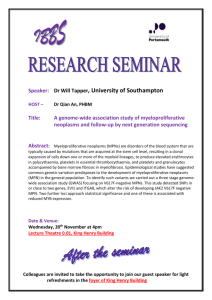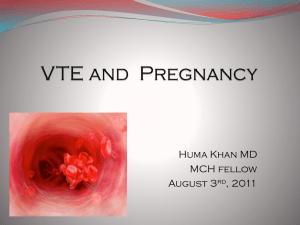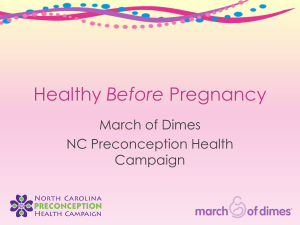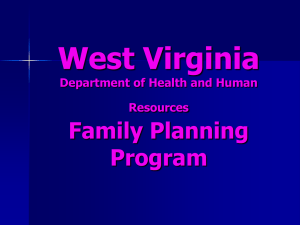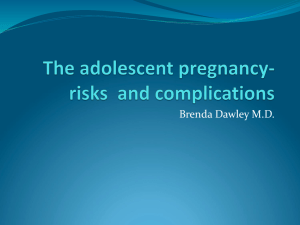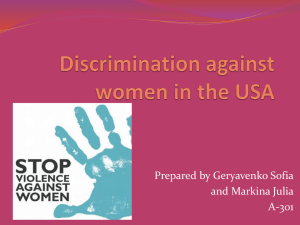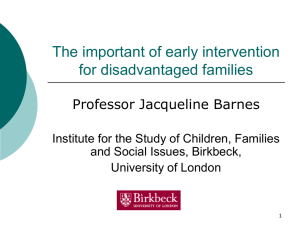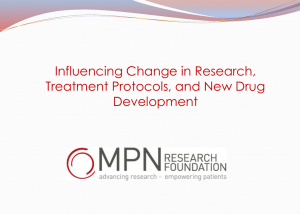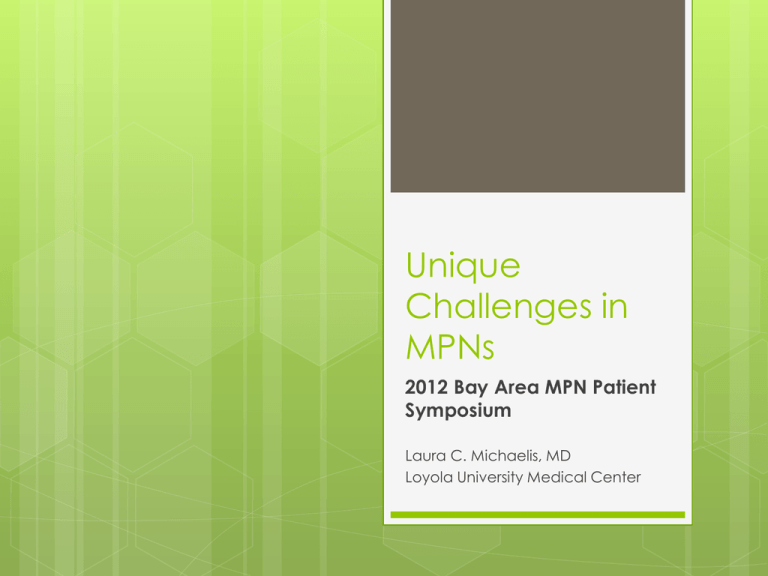
Unique
Challenges in
MPNs
2012 Bay Area MPN Patient
Symposium
Laura C. Michaelis, MD
Loyola University Medical Center
Topics to Discuss
Overview:
Gender and Cancer
Gender and MPNs
Special issues facing females with MPNs
Clotting
Pregnancy
Bleeding
Modifiable
risk factors – both genders
Conclusions
Cancer: Sex-based
differences
Breast
Ovarian
Cervical
Testicular
Prostate
Cancer: Gender-based
differences
Gender and Cancer
Does the disease occur more frequently in one
sex vs. the other?
Does the disease behave differently in one sex vs
the other?
Diagnostic bias?
Due to exposure?
Due to genetic predisposition?
Modulated hormones? Gender-based lifestyle
differences?
Interactions that we don’t understand?
Are there different consequences to the disease
or treatment that depend on gender?
Sex Ratio
Hematologic diseases
Disease
Male:Female Ratio
AML
1:1
ALL
1.3:1.0
HD
1.3:1.0
Multiple Myeloma
1.4:1
CLL
2:1
CML
3:2
ET
Female Predominance
PV
1.2:1.0
MF
1:1
25-29
30-50
Over 50 years
Sex Ratio: MPN
More women
diagnosed
than men
All MPNs
Essential Thrombocythemia
More men
diagnosed
than women
Cartwright et al.
British Journal of Hematology 2002, 118 1071-1077
Clinical Trial Inclusion
Trial
Total
Patients
HU in High-Risk ET
NEJM 1995
114
ASA in PV
NEJM 2004
518
308
(59%)
210
(41%)
HU vs Anagrilide in high-risk ET
NEJM 2005
809
342
(42%)
467
(58%)
Ruxolitinib in MF (US Study)
NEJM 2012
309
167
(54%)
142
(46%)
Male
Female
37 (32%) 77 (68%)
Topics to Discuss
Overview:
Gender and Cancer
Gender and MPNs
Special issues facing females with MPNs
Clotting
Pregnancy
Bleeding
Modifiable
risk factors – both genders
Conclusions
Challenges: Clotting
ET – most common
MPN in fertile women
Hormonal
contraception + ET =
hypercoaguable state
Pregnancy + ET =
hypercoaguable state
Thrombosis -- #1 cause
of maternal death
Challenges: Fertility
Contraception
Combination hormones
>progesterone only OCPs
General population have a 3–6fold increased risk of venous
thrombosis with OCPs
One
retrospective study of
>300 patients. Subset on OCPs
ET + OCPs = 23% VTE
ET no OCPs = 7% VTE
Challenges: Pregnancy
Pregnancy
outcomes likely impacted
Live birth rate 50-70%
First trimester loss 10-20%
Late pregnancy loss 10%
Increased rates of placental abruption,
intrauterine growth restriction
Can
we change those outcomes?
Preconception Counseling
Risk
Assessment
Prior VTE or arterial clot
Prior hemorrhage
Prior pregnancy complication
Diabetes or Hypertension requiring
treatment
Platelet count of >1500 X 109 before or
during pregnancy
Preconception Counseling
Multidisciplinary
approach
Discussion of teratogenic drugs
Therapeutic options
Aspirin
LMWH
Cytoreductive therapy
Delivery
and post-partum plan
Breastfeeding information
Pregnancy: Low-Risk Patients
Antiplatelet agents
reduce risk of
VTE in ET patients
Generally
Keep
HCT under 45%
Consider venesection if
necessary
Pregnancy is
thrombotic
Aspirin is likely safe
in pregnancy
(APLA pts)
Continue low-dose
aspirin
Monitor platelet or Hct
Increased plasma
volume of pregnancy
means no set targets
Pregnancy: High-risk patients
Remove possible teratogeneic drugs
Cytoreduction
Taper off hydrea or anagrilide 3-6 months prior to
conception
Hydrea likely contraindicated, men and women
Anagrilide crosses the placenta
Interferon-alpha -- Case reports indicating likely
safe
Prevent Clotting
LMWH
Prophylactic or, in some cases, therapeutic doses
Challenges: Bleeding
More
common when platelets are elevated
1,000-1,500 X 109
Often related to acquired Von Willebrands Disease
Occurs in both men
And women
Topics to Discuss
Overview:
Gender and Cancer
Gender and MPNs
Special issues facing females with MPNs
Pregnancy
Clotting
Bleeding
Modifiable
risk factors – both genders
Conclusions
Outcomes:
Venous, Arterial
Events like stroke,
heart attack, VTE,
bleeding
Exercise
HTN
control
MPN
Smoking
lipids
DM
Healthy
Weight
Conclusions
Get
involved in your care
Ask questions
Participate in clinical trials
Control what you can
Any
questions?

